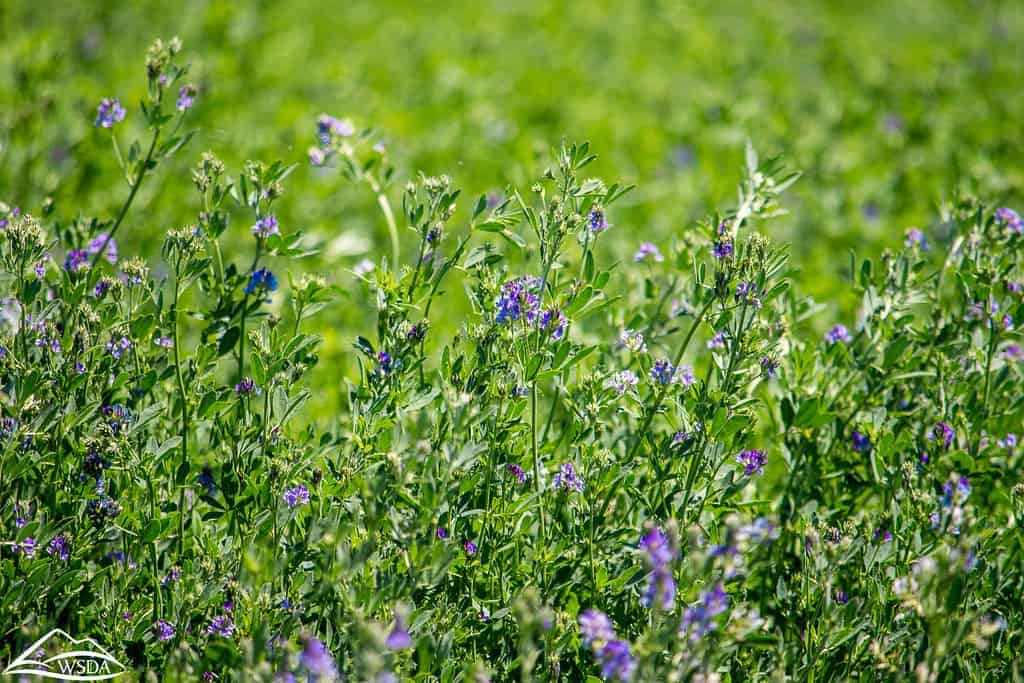Space, the final frontier. But as any good frontiersman knows, you can’t explore on an empty stomach. Eventually, then, we will have to grow food in space for astronauts to dine on — but what should we grow? A new study points to an unlikely candidate, a plant that today serves as livestock feed.

While the Moon is our closest cosmic neighbor, Mars is a much more enticing target for colonization due to its size and present (if thin) atmosphere. The idea of terraforming Mars — engineering it towards an Earth-like state with a breathable atmosphere, fertile soils, and liquid water oceans — is also quite enticing. Establishing reliable agriculture on Mars would go a long way towards serving both of those goals.
But the soils on Mars are exceedingly poor; the dusty and gritty material is virtually devoid of any organic matter. Its chemistry is also quite inhospitable for most plants, being very rich in salts and harsh minerals. Finally, there is no microflora in this material to help plants absorb essential nutrients or to cope with environmental conditions, as on Earth.
But new research suggests that one economically-important forage crop you probably never heard of could help to bring agriculture to Mars.
All about alfalfa
“The low nutrient content of Martian soil and high salinity of water render them unfit for direct use for propagating food crops on Mars,” write the researchers in their published paper. “It is therefore essential to develop strategies to enhance nutrient content in Mars soil and to desalinate briny water for long-term missions.”
Alfalfa is an unfussy crop that can survive in some of the poorest soils on Earth. This ability would lend well to the tough, volcanic material that covers the surface of Mars, which isn’t exactly soil, but regolith. According to a new study, alfalfa could be capable of surviving and developing in regolith. The plants can then be harvested and allowed to decompose to act as fertilizer for substrates in which food crops like turnips, radishes, and lettuce can be grown.
The process is similar to the concept of crop rotation here on Earth, where patches of field are sown with different crops at different times. Some of these crops, most notably food- or cash crops, drain nutrients from the soil as they grow. Plants that have little economic importance, like clovers or alfalfa, are then sown and allowed to decompose on the site to enrich the soil with fresh nutrients. Using this approach, although an individual plot of farmland is partially used to grow a ‘useless’ crop, the overall productivity of desired crops increases compared to what a permaculture field could produce.
On Mars, using such an approach is absolutely vital for agricultural efforts, as regolith cannot support plant life in the same way as soils do on Earth due to its lack of organic matter to provide vital nutrients — but alfalfa can help supply this.
Although getting an exact match for Martian regolith is tricky, the team mixed the best approximation of it they could and set to work testing how well different seeds could grow in it. Alfalfa performed the best — to their surprise, it developed just as well as control seeds placed in soil, without needing any additional fertilizer.
Then, the team added alfalfa as fertilizer to the regolith proxy and tested how well three crops could grow in this mixture. They chose turnips, radishes, and lettuce, as these species grow quickly, don’t need much water, and require little maintenance. All three crops developed well in the substrate.
One catch the team notes, however, is that even these three crops required fresh water to be added into the alfalfa-enriched regolith to grow. To the best of our knowledge, all water available on Mars is briny (it contains salt). In order to make this liquid suitable for farming, it needs to be treated and desalinated. A procedure to do so, which would involve the use of a species of marine bacteria and physical filtering through volcanic rock, is also described in the paper.
“For the first time, we report an integrated use of a biofertilizer and microbe for effective treatment of basaltic regolith soil and briny water simulants, respectively, for suitable resources that sustain plant growth,” write the researchers.
One obvious limitation of the current research is that the substrate used to simulate Martian regolith is not a perfect replica of that material; as such, alfalfa seeds may behave differently once they’re actually planted on Mars. That being said, short of going to Mars and retrieving a handful of its dusty ground, there’s not much we can do to work around that issue.
Another factor to take into account is that Martial soils contain perchlorate salts, which are toxic to plantlife. These were present in the experimental substrate the team used but in much lower quantities. According to the authors, this compound will need to be washed out of Martian soils through some means to give any crops a chance at developing.
Even these hurdles, however, should be much cheaper and easier to overcome than it would be to transport all the food a mission to Mars and its colonists would require. It’s simply not feasible to build, supply, and operate enough refrigerated supply ships to feed a colony on Mars with the technology we have now. The findings, however, give us cause for celebration: such efforts would not be necessary.
“This study signifies that for long-term purposes, it is possible to treat in situ soil and water resources for farming on Mars to sustain human missions and permanent settlements,” write the researchers.
The paper “Farming on Mars: Treatment of basaltic regolith soil and briny water simulants sustains plant growth” has been published in the journal PLOS One.


